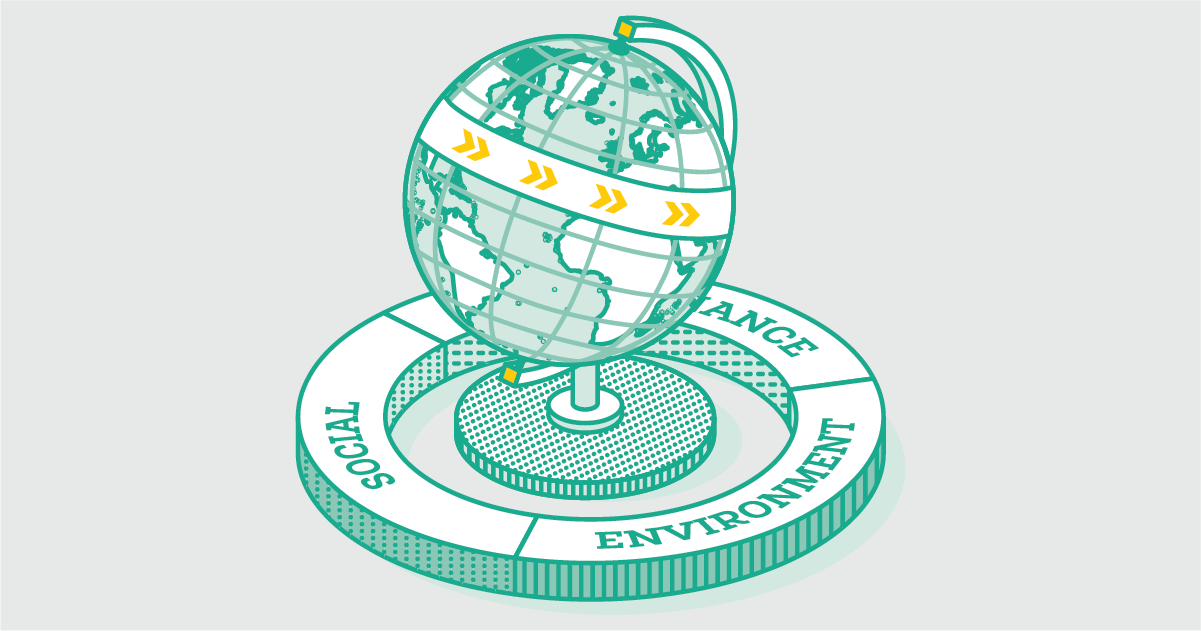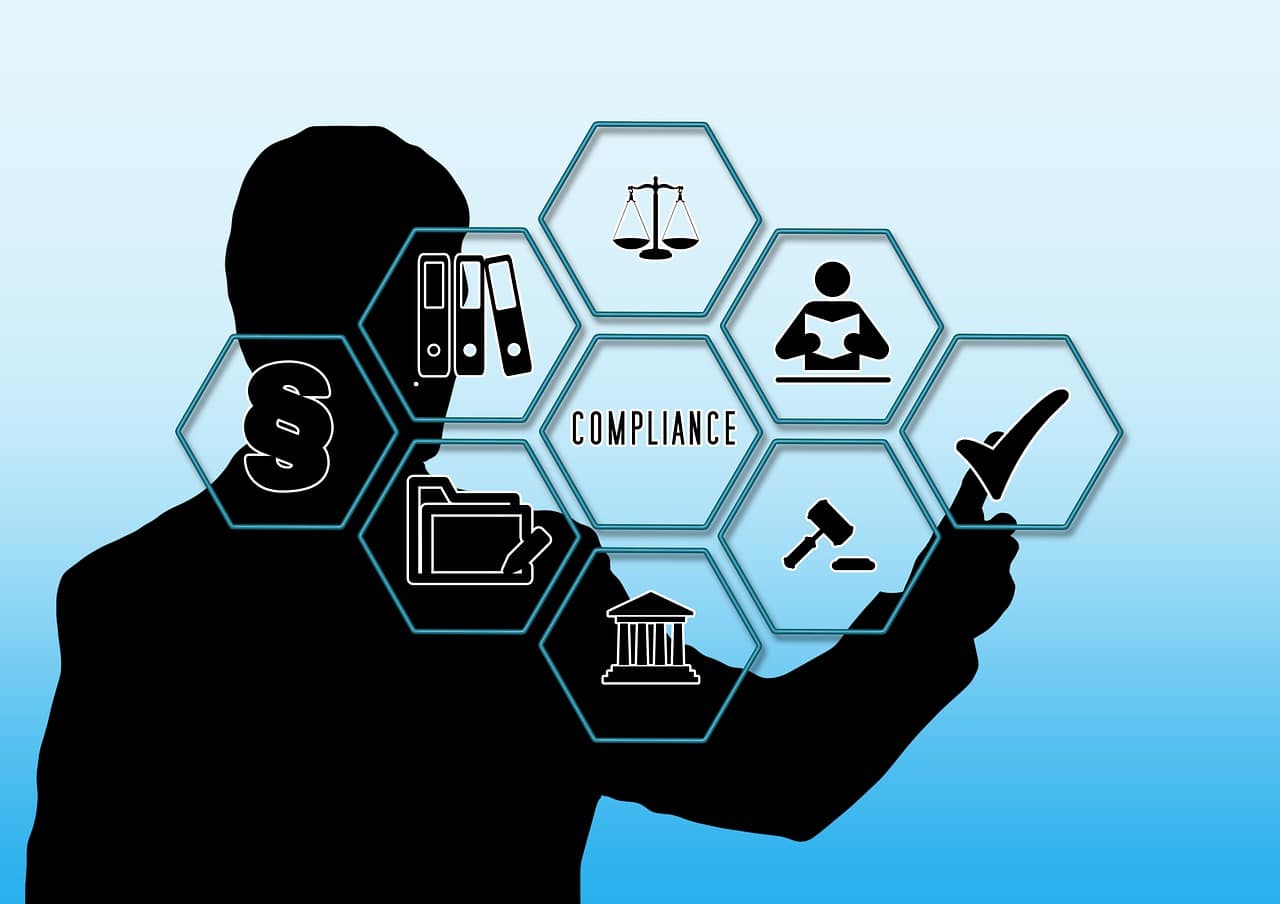While sustainability has been around for decades, full-blown ESG programs are relatively new to the market. Yet due to the shared ideology between sustainability and ESG, there are a surprising number of examples today that demonstrate an array of sustainable possibilities within the environmental scope of ESG.
In this article, we’ll review five different environmental scope examples across several industries. Loaded with practical ideas, reference these use cases as you execute the environmental scope of ESG in your own organization. Remember, the environmental scope of your ESG program should be designed to fit the uniqueness of your industry. What is in scope for a biohealth company will likely not be in scope for a fashion retail business.
Environmental Examples in ESG
The following examples have been curated based on the variety and depth of executed environmental scope of true ESG programs. Examples represent best-in-class strategies by industry and execution.
Financial Services Industry
Strategy: Solar farm investment
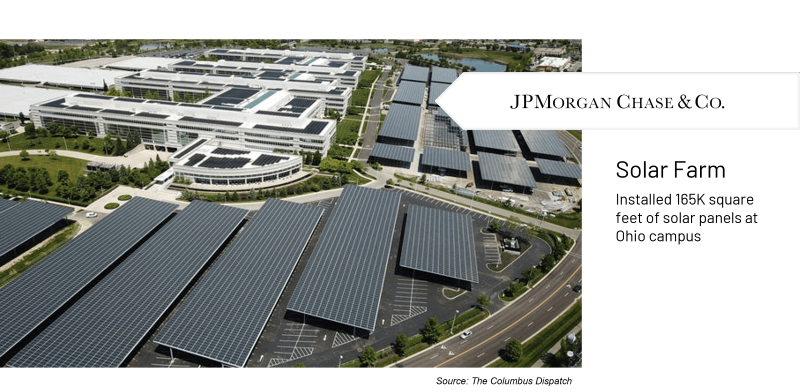
JPMorgan Chase has invested heavily in reducing its carbon footprint to lead its industry in ESG.
Their campus is in Columbus, Ohio, and it’s the second-largest single-use building in the United States after the Pentagon. Given the size of this campus, they focused their environmental goals on GHG emissions to ultimately reduce their Scope 1, Scope 2, and Scope 3 impact by almost half.
To begin tackling these lofty goals, JPMorgan Chase started by installing 165,000 square feet of solar panels on building roofs and parking garages across their campus. The new solar energy source fuels 75% of the campus’ power needs. This was a huge, meaningful start to their long-term initiative.
Taking their program to the next level, they began using weather data to evaluate patterns and weather impact on GHG emissions at their Columbus campus. Using this data, they could predict the hottest days of the year, and consequently, implemented employee work-from-home days to reduce overall energy usage.
Learn how automation creates consistency and ease in ESG management
Oil & Gas Industry
Strategy: Carbon capture & storage technology
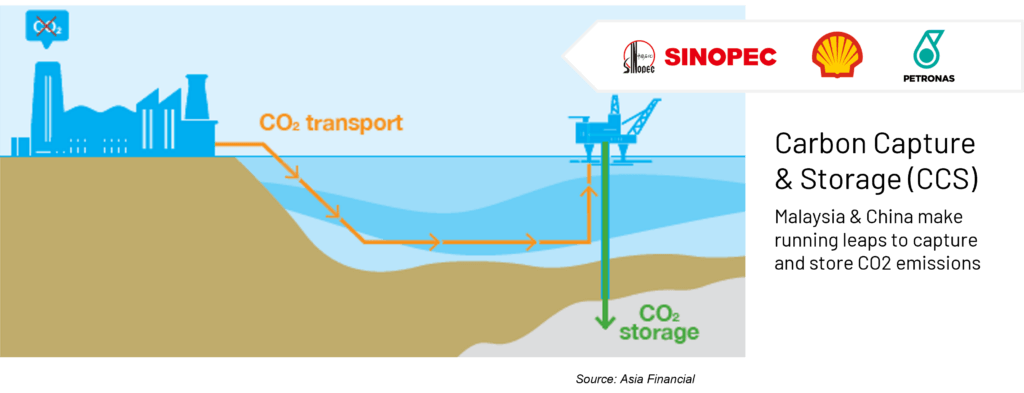
Several oil & gas refineries and producers are working to put themselves at the forefront of the climate challenge by leveraging their technology infrastructure for carbon capture and storage (CCS). CCS is the process of capturing carbon from greenhouse gas (GHG) emissions and permanently storing it, typically underground. With the vast network of oil & gas pipelines, the CCS process is a natural fit and has become a centralized focus among their climate initiatives.
Asia is leading the charge publicly with its commitment to CCS. Royal Dutch Shell and Petronas (a Malaysian state-owned oil & gas company) partnered together to pool resources and technologies to develop the first sustainable carbon capture and storage process to serve their regions.
China’s largest oil supplier and second-largest oil producer, Sinopec, announced a goal of achieving carbon neutrality by 2050. CCS is the core component of their carbon neutrality roadmap. Additionally, Sinopec is exploring an opportunity to reuse carbon by mixing carbon dioxide with crude oil to generate higher oil production.
A common theme across industries is not just how to reduce our environmental footprint but finding opportunities to reuse and even monetize the recycling process.
Food Production Industry
Strategy: Regenerative agriculture
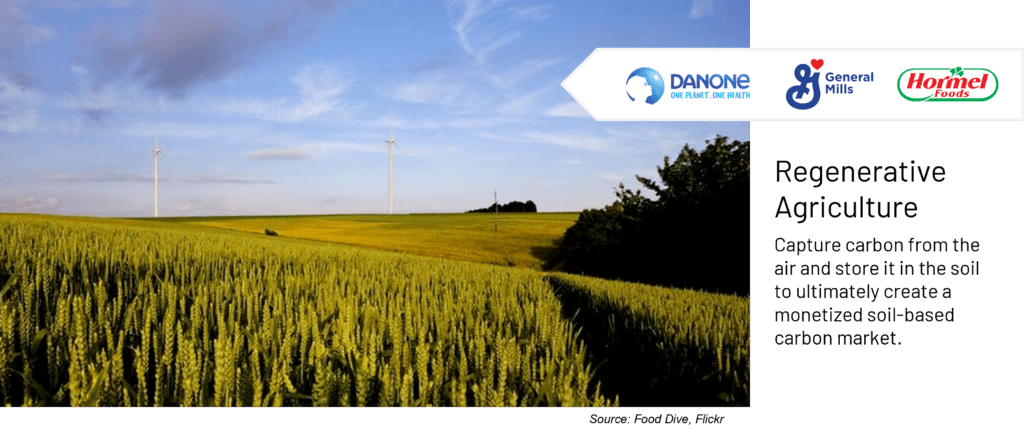
Nine plants represent two-thirds of the world’s crop production: sugar cane, maize, rice, wheat, potatoes, soybeans, palm oil fruit, sugar beet, and cassava. This lack of biodiversity means that a natural disaster, rising sea levels, temperatures, or even an infestation could have disastrous implications for the global food system.
Food production companies have been keeping a close eye on this situation to identify ways to diversify and add stability to the farming process. Food producers Danone, General Mills, and Hormel are all investing in regenerative agriculture, which is designed to scale alternative farming practices. Carbon sequestration is one such practice and involves capturing carbon in the soil to increase the soil’s ability to hold water and hopefully build resilience in the crops. These efforts are designed to retain nutrient-dense soil and crops while supporting the livelihoods of farmers and reducing synthetic inputs throughout the farming process.
Other food producers are looking to increase biodiversity and crop resilience in their agriculture models by hyper-local sourcing. This approach invests in the land’s natural biodiversity makeup and supports local communities.
Get ESG ideas from best-in-class social examples across industries
Retail Industry
Strategy: Collective green sustainability

Starbucks holds a reputation for being a company that is conscious of its social impact in communities but is often overlooked for its strides in the environmental space. With more than 32,000 stores around the world, their small decisions make a huge impact at scale.
Every new retail outlet Starbucks opens has LED certification, the first of which is their Downtown Disney store in California. Their green strategy is not unique to only new retail outlets but is applied across existing stores as well. Starbucks’ comprehensive approach includes micro adjustments to reduce energy consumption. For example, air conditioning—which is commonly set at 72 degrees—is bumped up to 75 degrees. Water conservation is managed by utilizing low-flow water valves on all faucets. Rethinking product packaging, including more reusable packaging, reduces the waste management footprint of retail outlets.
Manufacturing Industry
Strategy: End-to-end energy management
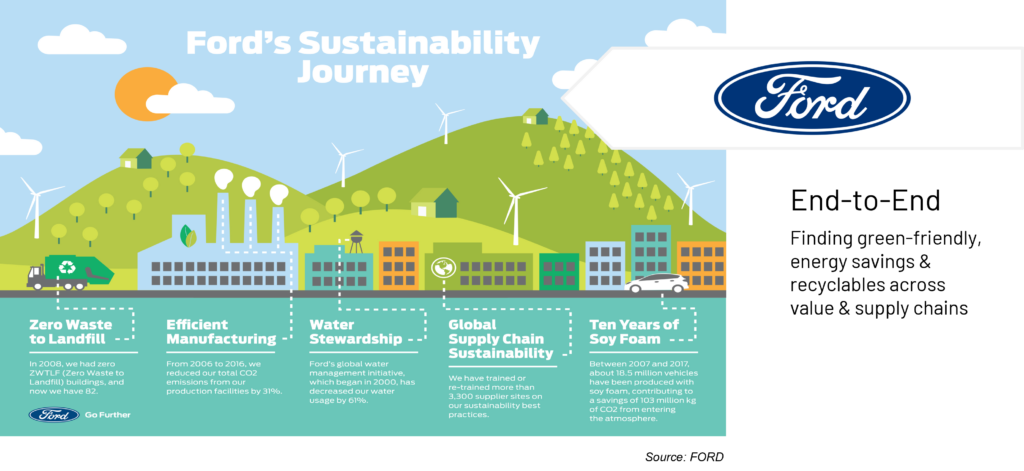
The last example is Ford, which uses an end-to-end environmental journey. At their Dearborn, Michigan plant location, Ford installed environmentally friendly and sustainable processes, including a living roof system, solar thermal collectors, porous pavement, underground storage basins, and natural wetlands and retention ponds.
These improvements have resulted in reduced pollution and more efficient energy usage. The combination of porous pavement and underground storage basins filter stormwater to reduce pollution runoff to the nearby river. The solar thermal collection heats water in the building, while the living roof system reduces the temperature of the plant by 10 degrees in summer and heats it by 10 degrees in the winter.
Outside of Dearborn, Ford deploys differing strategies that better fit the local environment. For example, manufacturing plants in Nordic countries are powered by wind turbines and hydropower.
Ford also purchases carbon offset credits to fund renewable energy projects and follows ISO 14001, a voluntary international environmental management system standard.
How to learn from these examples
Use these environmental scope examples to kickstart ideas that will translate well within your industry and business. ESG is not a one size fits all approach, so consider the multitude of strategies and executions already in play by others today.
Evaluate feasibility against impact to prioritize your ideas. You might need to take the Starbucks approach by retroactively incorporating green initiatives into existing physical locations instead of starting with new construction. In other cases, you might not have the means to lower GHG emissions low enough, so purchasing carbon credits might be your best option.
Visualize where your organization can go and then start planning against a framework that works to achieve your company’s environmental goals.
